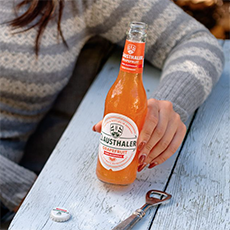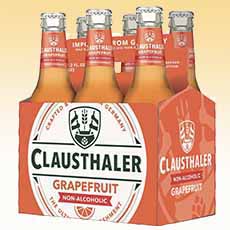Clausthaler Grapefruit Non-Alcoholic Beer For Dry January
|
We’re enjoying the first week of Dry January with Clausthaler Grapefruit Non-Alcoholic Beer. It marries the refreshing flavors of a lager beer and fresh grapefruit juice. Don’t like grapefruit? This NA* brand that includes Claustahler Original, Clausthaler Dry-Hopped (tastes like an IPA), and Santa Clausthaler, a holiday delight. If you’ve tried other NA brands and responded, “meh!”, give Clausthaler a try. Clausthaler Grapefruit NA beer and the other Clausthaler varieties are an easy and tasty way to give up booze the month (or whenever you need to hold back on the alcohol). More than 50 years ago, Clausthaler patented the process for brewing beer without alcohol. Clausthaler Original was launched in 1979, the world’s first non-alcoholic beer. Clausthaler first made its mark in the canteens and cafeterias of the German labor force. At last, people could enjoy a cold beer in the middle of the workday without the worry of intoxication. The brand was an instant success [source]. The brewery, which only produces non-alcoholic beer, continued to innovate with new flavors to meet the growing demand for good non-alcoholic beer. The year-round lineup includes Original, Dry Hopped, Grapefruit, and (in Europe only), Unfiltered Dry Hopped and Lemon. During the holiday season, Santa Clausthaler, brewed with seasonal spices, is a treat. Clausthaler is the most popular non-alcoholic beer in Europe, and winner of the World Beer Awards World’s Best Alcohol-Free† Beer. Clausthaler’s unique brewing process produces non-alcoholic beer that actually conforms to the Reinheitsgebot, the German Purity Law of 1516. *Non-Alcoholic. †According to the Food and Drug Administration, a product labeled alcohol-free beer must contain no detectable levels of alcohol. These beers should be labeled 0.0% A.B.V. Products labeled non-alcoholic beer can contain up to 0.5% A.B.V. Different countries can have different regulations [source]. ‡A.B.V. is the acronym for Alcohol By Volume, which refers to the percentage of a drink that is pure alcohol. To get the proof, you double the A.B.V. Thus, an 80-proof vodka is 40% A.B.V. Clausthaler beer is .9% A.B.V. Double that and the proof is less than 1%, but it’s still a teeny bit of alcohol. |
|
|






